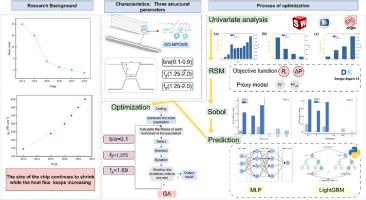基于双预测模型的高热流下Cantor分形微通道结构优化
IF 5
2区 工程技术
Q1 ENGINEERING, MECHANICAL
International Journal of Thermal Sciences
Pub Date : 2025-09-13
DOI:10.1016/j.ijthermalsci.2025.110298
引用次数: 0
摘要
随着芯片集成度和计算量的不断提高,局部热流密度呈指数级增长,对微电子散热技术提出了严峻的挑战。传统的微通道散热器(MCHS)在高热流密度(qw)条件下难以实现协同热工优化,传热增强趋于饱和,而压降(ΔP)随雷诺数(Re)的增加呈非线性增长。本研究提出了低Re条件下Cantor分形微通道结构的分阶段建模和优化策略,旨在平衡热阻(Rt)和ΔP性能。首先,进行了单变量分析,以评估关键几何参数如何影响CF-MCHS的流动和热性能。然后建立响应面模型来解耦结构参数的局部影响和相互作用趋势。随后,引入Sobol敏感性分析来量化全局参数贡献并揭示高阶相互作用效应。针对传统替代模型在高度非线性条件下存在的不足,本研究建立了LightGBM模型和MLP神经网络来独立预测ΔP和rt,并引入了基于归一化加权目标函数的遗传算法(GA)来搜索最优结构参数。确定最优参数集为b/a = 0.1, fy = 1.375, fx = 1.69。对优化后的结构进行了数值模拟,结果表明预测值与模拟值的相对误差小于5%。结果表明,与基准结构相比,优化后的设计在保持温度变化可控的情况下,最大降低ΔP 28.84%。该研究为高量子瓦下电子系统分形热管理策略的设计提供了理论基础和工程指导。本文章由计算机程序翻译,如有差异,请以英文原文为准。

Dual prediction model-based optimization of Cantor fractal microchannel structures under high heat flux
With the continuous increase in chip integration and computational load, the exponential growth of local heat flux density poses a formidable challenge to microelectronic cooling technologies. Traditional microchannel heat sinks (MCHS) encounter difficulties in achieving coordinated thermal-hydraulic optimization under high heat flux (qw) conditions, where heat transfer enhancement tends to reach a state of saturation, while the pressure drop (ΔP) exhibits a nonlinear growth with increasing Reynolds number (Re). This study proposes a phased modeling and optimization strategy for Cantor fractal microchannel structures under low Re conditions, aiming to balance thermal resistance (Rt) and ΔP performance. Initially, a single-variable analysis was conducted to evaluate how critical geometric parameters influence the flow and thermal performance of the CF-MCHS. A response surface model (RSM) is then constructed to decouple the local influence and interaction trends of structural parameters. Subsequently, Sobol sensitivity analysis is introduced to quantify the global parameter contributions and uncover higher-order interaction effects. To address the shortcomings of traditional surrogate models in highly nonlinear regimes, this research develops a LightGBM model and an MLP neural network to independently predict ΔP and Rt. A genetic algorithm (GA) is introduced based on a normalized weighted objective function to search for the optimal structural parameters. The optimal parameter set is determined to be b/a = 0.1, fy = 1.375, and fx = 1.69. Numerical simulations conducted on the optimized structure confirm that the relative error between predicted and simulated values remains below 5 %. It is evident that, relative to the baseline structure, the optimized design achieves a maximum ΔP reduction of 28.84 % while maintaining controllable variations in Rt. This research offers theoretical foundations and engineering guidance for the design of fractal-based thermal management strategies for electronic systems operating under high qw.
求助全文
通过发布文献求助,成功后即可免费获取论文全文。
去求助
来源期刊

International Journal of Thermal Sciences
工程技术-工程:机械
CiteScore
8.10
自引率
11.10%
发文量
531
审稿时长
55 days
期刊介绍:
The International Journal of Thermal Sciences is a journal devoted to the publication of fundamental studies on the physics of transfer processes in general, with an emphasis on thermal aspects and also applied research on various processes, energy systems and the environment. Articles are published in English and French, and are subject to peer review.
The fundamental subjects considered within the scope of the journal are:
* Heat and relevant mass transfer at all scales (nano, micro and macro) and in all types of material (heterogeneous, composites, biological,...) and fluid flow
* Forced, natural or mixed convection in reactive or non-reactive media
* Single or multi–phase fluid flow with or without phase change
* Near–and far–field radiative heat transfer
* Combined modes of heat transfer in complex systems (for example, plasmas, biological, geological,...)
* Multiscale modelling
The applied research topics include:
* Heat exchangers, heat pipes, cooling processes
* Transport phenomena taking place in industrial processes (chemical, food and agricultural, metallurgical, space and aeronautical, automobile industries)
* Nano–and micro–technology for energy, space, biosystems and devices
* Heat transport analysis in advanced systems
* Impact of energy–related processes on environment, and emerging energy systems
The study of thermophysical properties of materials and fluids, thermal measurement techniques, inverse methods, and the developments of experimental methods are within the scope of the International Journal of Thermal Sciences which also covers the modelling, and numerical methods applied to thermal transfer.
 求助内容:
求助内容: 应助结果提醒方式:
应助结果提醒方式:


